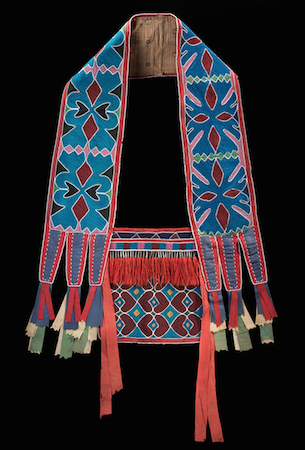What Size Beads Are Used For Bead Weaving On Bandolier Bags
Complete Identification: Bandolier bag no known artist 1850 C.E. Beadwork on leather Lenape people Delaware tribe, Eastern Woodland Course: Bandolier and purse are continued Bandolier Cherry trimming effectually entire material and tassels at the end Floral blue, blackness, dark-green, and pink design on textile Ends of the bandolier have trapezoidal extensions which end in green, crimson, tan, and blue tassels The bandolier is a long rectangle, would accomplish beneath the waist (only probable not to the knees) Only one side of the bandolier is decorated → the other side is brown Handbag Follows same color story as bandolier → shares the pink, blueish, and scarlet Tassels decorate the opening of the bag (shorter and thinner than the tassels on the bandolier) Rectangular in shape Part: Bandolier bag is worn as a cross-body bag → a strap crosses the breast and allows the pocketbook to remainder on the hip Numberless were unremarkably decorative → even those with pockets were non necessarily used to hold anything Men could wear more than one purse at a time Express group identities and social status Peculiarly in the face of displacement → stand for the determination and perseverance of Lenape people and Lenape civilization Content: There are thousands of beads strung together across the bandolier purse's surface Show mastery of technical skill Based on bags carried past European soldiers that held ammunition for rifles Big in size Trade fabric (cotton, wool) and hibernate are used as the base of operations for the bags and straps Seed chaplet (tiny glass beads) are acquired from trading with Europeans Prized for color Replaced porcupine quills every bit base for colors in the numberless Porcupine quills would be dyed and woven into the cloth Silk ribbons are likewise used for decoration → gained from trading as well Expanded the surface of the bag in an interesting mode Trading with the Europeans allowed for new materials to be added as ornamentation to the bags Replaced farther quillwork and dying of the bandolier's fabric Chaplet would reverberate sunlight, ribbons would flap in the wind Red wool tassels on the bag are attached with metal cones → add together more colors and textures Designs Abstracted and asymmetrical White beads act as contour lines Each side is slightly different in design Minor size of the chaplet allows for more intricate designs than quillwork Contrasting colors could represent Sky and Underworld realms Design could besides represent central directions, every bit they become in 4 different directions Context: Called Aazhooningwa'on in Ojibwe language ("worn across the shoulder") Made across tribes in Smashing Lakes and Prairie regions Styles depend on tribe and on contact with Europeans (for materials) Bandolier bags specially popular in Woodlands region (Not bad Lakes and territory East of Mississippi) in nineteenth century Women created the bags, while by and large men wore them Prairie style Incorporates styles from older Delaware traditions also as other displaced native peoples Effect of dissimilar peoples coming together Used glass beads to make abstract or representative floral patterns against a dark background Bandolier numberless still worn today → show preservation of culture Lenape Originally from Delaware → the Eastern woodlands Some lived in big villages but nearly lived in smaller communities of upward to 25 people Had 3 clans (Wolf, Turtle, Turkey) that traced lineage through mother's ancestry Very communal → land belonged to community, shared shelters, no theft Political leaders were chosen based on leadership characteristics and ability to pb successfully State of war leaders were called based on success in battle They could human action without the approval of the political leader Men Woodcraft and hunting, cleared the land, built/repaired houses Women Housekeeping, gardening, planting and harvesting crops Making clay pots; weaving; making slippers, mats and dolls; preparing hides for clothes and shelters Were removed from their bequeathed lands by Indian Removal Act (during Jackson's presidency) but kept their traditions in creating fine art Bandolier numberless are an instance of the perseverance of their culture Religion was animistic → spirits (both helpful and harmful) were everywhere and should exist treated with respect Ceremonies throughout year to drive off evil spirits and celebrate good ones Celebrations of maple tree and corn planting, harvest rituals Shamans were important spiritual leaders (sometimes political likewise) Themes: Materials and symbolism Relationship with nature Colonialism Effects on culture Effects on fine art Lasting effects of displacement and cultural improvidence/dispersement Cross-Cultural Connections: Reflects the importance of textiles every bit an individual fine art form in the Americas (peculiarly in Inca culture) Textiles are not used to imitate other fine art forms In fact, other art forms often imitate textiles Textiles are a circuitous and technically challenging art form, which shows the mastery of the indigenous peoples over this form Sources: https://world wide web.khanacademy.org/humanities/ap-art-history/indigenous-americas/a/bandolier-pocketbook https://world wide web.lenapelifeways.org/lenape1.htm 
What Size Beads Are Used For Bead Weaving On Bandolier Bags,
Source: https://sites.google.com/site/adairarthistory/v-indigenous-americas/163-bandolier-bag
Posted by: rubywormuch.blogspot.com


0 Response to "What Size Beads Are Used For Bead Weaving On Bandolier Bags"
Post a Comment